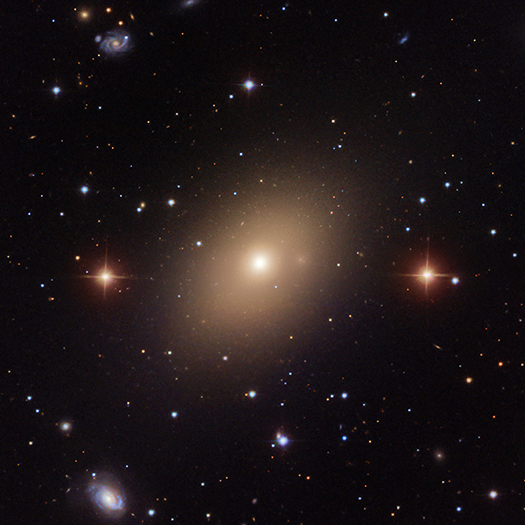
NASA astronomers using the Chandra X-ray Observatory probe have discovered a unique group of galaxies that appear to have undergone substantial restructuring due to multiple eruptions from a supermassive black hole. The eruptions took place over 50 million years, astronomers say. These eruptive bursts of energy caused shockwaves and pushed surrounding gas in the galaxy cluster away from the black hole’s center, causing visible cavities much like giant bubbles. Researchers were able to determine the length of the black hole’s eruption period by studying these cavities. The Astrophysical Journal published this study in its June, 2015 issue.
This galactic group, called NGC 5813, lies 105 million light years from Earth and is comprised of no more than 50 different galaxies all enveloped in large amounts of hot, X-ray emitting gas.
The erupting supermassive black hole is located in the central galaxy of the group. According to a June 10 statement from the Chandra mission, the black hole’s spin, and the large amount of heated gas spiraling toward its center, cause:
… a rotating, tightly wound vertical tower of magnetic field that flings a large fraction of the inflowing gas away from the vicinity of the black hole in an energetic, high-speed jet.

Chandra’s most recent observations revealed a third pair of cavities, separate from the two that had previously been discovered in this group. The three cavities represent three distinct eruptions – the highest number ever observed in any galaxy group.
In order to discover more about the black hole’s volatile past, researchers focused on the appearance, energy, and location of the three cavity pairs. Surprisingly researchers determined that the energy required to create the cavities closest to the black hole’s center is lower than the energy required to make the older pair, which is further way from the center.
Researchers then determined that the rate of energy production from the supermassive black hole has remained constant, which indicates that the eruption associated with the inner cavities is actually still occurring.
Each of the three pairs of cavities is associated with a shock front, which is a visible sharp edge in the X-ray image.
These shock fronts, similar to a sonic boom from a supersonic jet, heat the surrounding gas and prevent it from cooling and coalescing into new stars.
Closer scrutiny of the shock fronts revealed they are blurred and broad, rather than sharp. this blurriness is now believed to result from turbulence in the heated gas. With this new insight, researchers have found an average speed of the random motions of the gas in NGC 5813. This turbulent velocity was determined to be 160,000 miles per hour, which is consistent with predictions in theoretical models.
The Chandra observations of NGC 5813 are the longest ever obtained of any galaxy group, lasting over a week. These observations demonstrate the ongoing story of supermassive black holes.
Still much of a mystery, the galactic group NGC 5813 continues to reveal how these massive forces help shape the landscape of our universe.

Bottom line: NASA astronomers announced in June, 2015 that they used the Chandra X-Ray Observatory to discover cavities – like giant bubbles – in the hot gas inundating galaxy cluster NGC 5813. A supermassive black hole in a galaxy at the cluster’s core is thought to have made these cavities via multiple eruptions over 50 million years, which caused shockwaves and pushed surrounding gas outward.
Enjoying EarthSky so far? Sign up for our free daily newsletter today!











